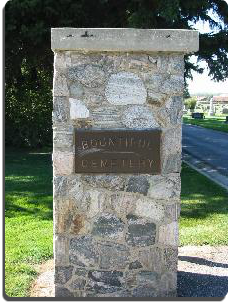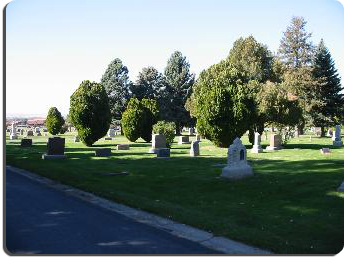History of Bountiful City Cemetery
The first burial plot in Sessions Settlement was near the spot where the Hogan Cabin now stands in Woods Cross. In the following few years 20 individuals, including two Indians, were buried there.
In 1854 a new cemetery site was selected at this present address, 2224 South 2nd West (there were no street or house numbers in
the Woods Cross burial ground to the new site.
In the early 1850's and 1860's there were no undertakers. The dead were packed in ice at home, and the neighbors sat with the body (the wake). Any vehicles available were used for conveyances, often white-top wagons and buggies in summer, sleighs in winter.
The funeral of John Fisher was the first to use a horse-drawn hearse, owned by William H. Streeper of Centerville. The wagon was white and very elaborate with drapes at the plate glass windows.
The cemetery was under the direction of local Bishops. As Bishops changed, a new deed had to be executed for the cemetery. Nora Stringham, descendent of Luther Burnham, holds a deed dated April 1874, deeding this property to the LDS Church. In 1880, the Bountiful Cemetery was put under the direction of Bishop Stoker (East Bountiful), Bishop Lewis M. Grant (West Bountiful) and Bishop Richard Egan (South Bountiful), with Samuel Smedley as Sexton. At this time the cemetery was divided into lots, with roadways between each group. Some hollows were filled and records were begun. Lots sold for $5.00, grave openings were $3.00.
In 1906 William Hill was recorded as sexton, serving for 26 years. His son succeeded him. On June 8, 1938 the LDS Church deeded the cemetery property to Bountiful City. In 1934, during WPA times, Ruby Stringham Garrett was given the responsibility of starting perpetual care. At that time the cemetery was leveled and lawn was planted.

Since Bountiful was the second settlement in the Utah Territory, this cemetery is one of the oldest cemeteries in the State. Some of the stately tall pines that form the border fronting Second West and adorn the cemetery throughout were raised from seed by Franklin D. Ashdown. Unfortunately, some of these trees were lost in the December 2011 windstorm.
The above information was taken from the "Bountiful Historical Walking Tour Booklet" pp. 2-3 and "Bountiful Area Historic Sites Tour Guide Booklet," pp. 10-11, Nora Stringham "East of Antelope Island," DUP and "The City of Bountiful," by Leslie T. Foy

